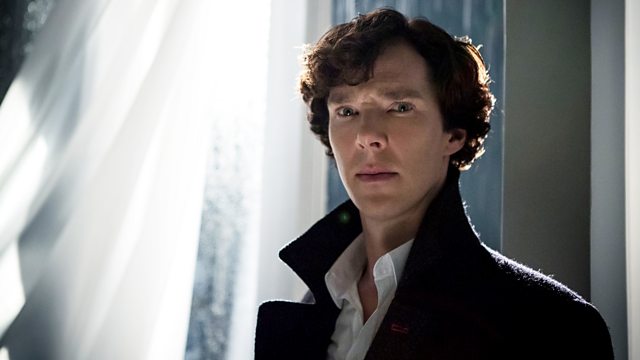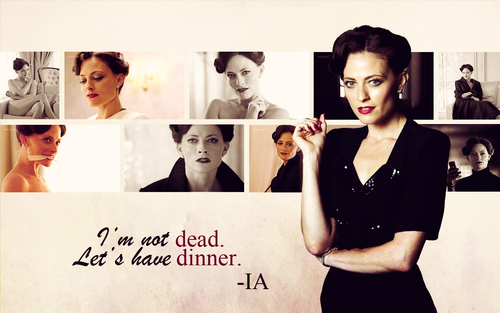 |
| From the BBC |
 |
| From Wikipedia |
 |
| From Wikipedia |
Benedict Cumberbatch offers a more convincingly Doyle Sherlock: the human machine, with the dependable homely Martin Freeman picking up the pieces.
And what do they do with this pair? They pop them into a story in which Doyle's gentle sweet governess Mary Morstan turns out to be an accomplished assassin and all-round liar! Flashback scenarios worthy of a bad acid trip take us on a whirligig nonsense trip ... actually I can't quite even remember the convolutions of the silly story. It started really well. Lindsay Duncan is a lovely Lady in distress - the scene when the villain licks her face and she is unable to protest is spine-tinglingly good. A newspaper proprietor as villain! I sat back in my chair prepared to enjoy a sharp commentary on 21st century society.
Then it all went tits-up.
 |
| From Mi Mundo blog |
 |
| From Fanpop |
This is how Conan Doyle described Irene Adler, in Watson's voice:
 |
| From 2000 irises |
What emerges from this is not anything about Irene Adler, or women. What emerges is something about the character of Holmes. He is an iconic persona of his age: 'the most perfect reasoning and observing machine'. At the peak of the industrial revolution, when machine was king, Conan Doyle wrote an allegory of the age. He wrote a story about a human who was the perfect machine.
Holmes is not just a 'machine'; he is a perfect brain. There is a more perfect brain in the Holmes stories: Mycroft, who doesn't exert himself as Sherlock does, he only moves in a stately and restricted circle between his government office and the Diogenes club. What does he become in the two adaptations of the Holmes stories? For Guy Ritchie he is the gay exhibitionist played by Stephen Fry. Like Robert Downey Jr.'s Sherlock, Fry's Mycroft is hugely entertaining and funny. In the Moffatt/Gattis version, he is played by Gattis. He is camp and devious compared to the more morally straightforward (a bit, OK, he does pretend to offer a woman a diamond engagement ring just to get into her employer's flat) Sherlock. Fun and fascinating although both are, neither would lead us to say: "brainy is the new sexy".
As usual in stories of this kind, it's the most obvious yet most overlooked character who is really the central figure. If we read Conan Doyle's Sherlock Holmes stories as an allegory of the machine age, and study of humanism, then we are being presented with the human as perfect machine in a way which makes us go: "Uh, no thank you." Secretly, however much we admire Sherlock, and even Mycroft, we think we are Watson. We are a bit bumbling and error-prone, humble humans. We fall in love. We might not be able to spot the essential clue and solve a mind-bending puzzle saving civilisation as we know it in seconds; but we are (luckily) capable of feeling the 'softer passions'.
What then of the Guy Ritchie and Moffatt/Gattis adaptations? Their Sherlock Holmeses are not perfect brains, they often show a human emotional side (Sherlock snogging Molly when she helps him 'die', Sherlock appearing in drag to save Watson and Mary on their honeymoon train). For them, women are not 'the woman', emblematic of their sex - to be admired and adored but at a distance. Women have come closer for these Sherlocks; they are insoluble problems so they become intensely annoying bits of grit in the machinery. Next to Irene Adler, Doyle's Sherlock is the perfect machine. Guy Ritchie's seems too immature to cope with her. The Moffatt/Gattis Sherlock is a sociopath.
As an allegory for our age, this is worrying. From being the actual fabric of society against which the perfect machine of the brain operates, humanity - frail, erratic, emotional - seems to have been lost. Humanity seems to have been condemned to representation in the problematic feminine. From being the one who picks up the pieces, it's become the spanner in the works of the perfect machine who needs to save civilisation as we know it.
Never mind, turn over for something different. Oh it's on the same channel - well, it is if you live in Wales.
 |
| From Wikipedia |
 |
| From Miss Peabody's blog |
The second episode of Hinterland gives us a story of families intertwined around land and legacies, relationships of all kinds: parental, marital, gone horribly wrong when people feel they have not inherited appropriately. What we have is a set of programmes that is no longer about men/women - humanity and the machine age. These are programmes about children, families. They are about sexuality/kinship in its widest (I would say Foucauldian) form, rather than the narrow sex/sexuality forming human identity (Freud).
Hinterland is even more than that. I moved to South Wales a decade ago. I was a bit grumpy, because I knew that once I settled here I would probably never move to Scotland where I was born after all. I remember traveling on the train not long after moving here, along the Severn Estuary past Chepstow Castle. I saw a low green hill with a twisted thorn tree on it. I saw the small green hillock as if it were the coiled Celtic emblem of the land of Dylan Thomas, the land whose literary genius Gerard Manley Hopkins struggled to celebrate in the cold English tongue. I knew I would stay.
 |
| Port Talbot chemical plant. |
There we are then, the ethos of the 21st century encapsulated in a new detective story from the oldest British colony. You can't yet see Hinterland in Baker Street, it's only being shown in Wales (although Danish tv has bought it). Instead of the modern Manichean mayhem of the battle of the sexes, here is a sensitive allegory exploring wider issues of family and belonging embedded in cameo shots of a human landscape.
(I just want to add, that it was after I wrote this that I saw producer Ed Talfan's blog on how the stories in Hinterland emerged from the Welsh landscape - she says smugly.)
It reminds me a little of the American SciFi/Fantasy series "Warehouse 13". 'H.G.Wells' turns out to be a tortured scientific genius who lost her (yes, her) child in the 19th century, went mad (obviously) and came back to destroy the world in the 21st century. Later she turned to the side of good but I always thought it a stroke of writerly genius to play on the ambiguity of the initials "H.G." (H stands for Helena by the way).
ReplyDeleteAlso what about "Elementary"? The US version where recovering drug addict Holmes is played by Johnny Lee Miller and his minder companion Watson by Lucy Liu. Now that's an update.
http://www.starmedia.us/imagenes/2013/07/elementary-sherlok-holmes.jpg
DeleteNO! I hadn't heard of Elementary, although I still don't believe it can have been as bad as this episode of Sherlock - gah! xxx